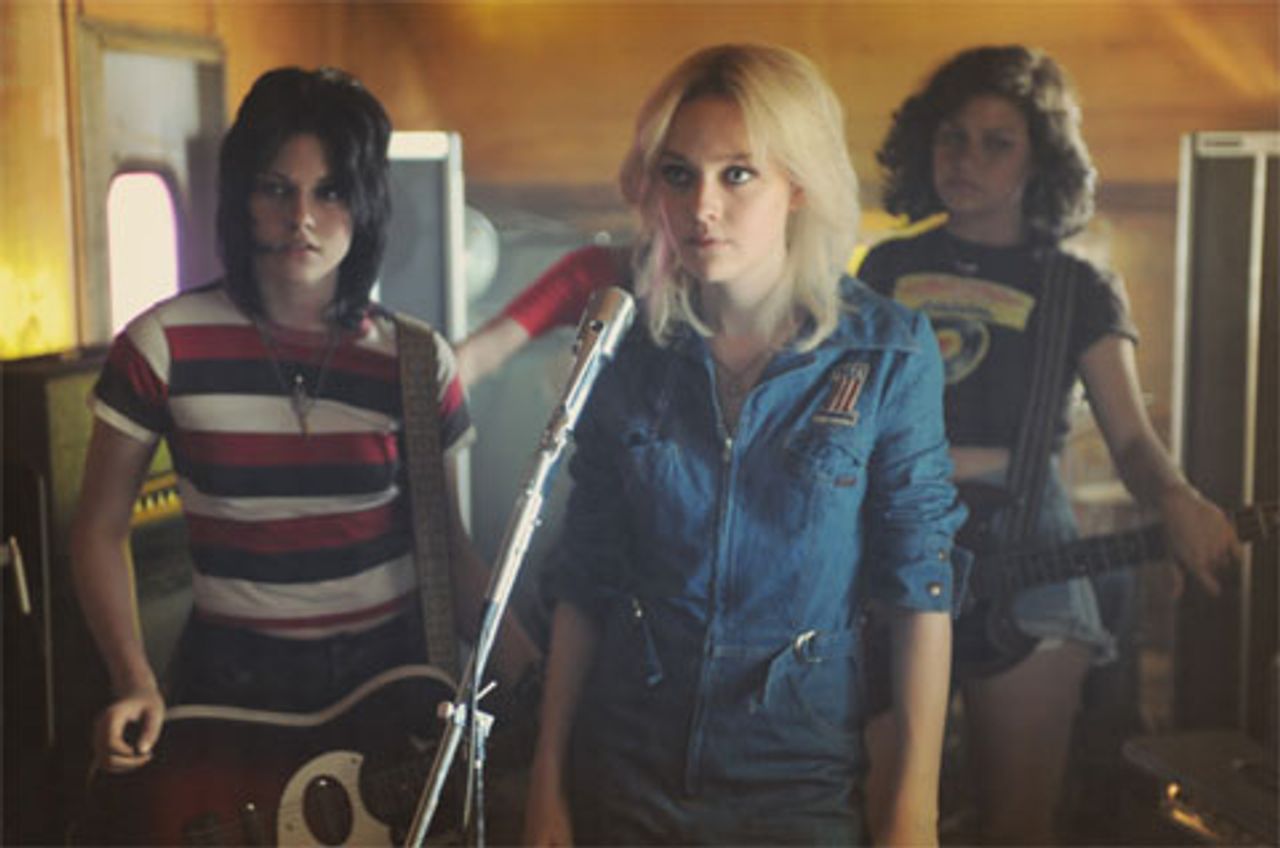Formed in 1975, the Runaways were an all-girl rock band whose music fit in somewhere between the glam rock of David Bowie and the punk bands that emerged around 1977. The group is best known today for their song “Cherry Bomb” and for having been the first band of both Joan Jett and Lita Ford, who would each have a successful solo career during the 1980s.
 The Runaways
The RunawaysThe film The Runways attempts to tell the band’s story, focusing primarily on Jett and lead singer Cherie Currie. As the story begins, it’s 1975 and the teenage Jett (Kristen Stewart) and Currie (Dakota Fanning) are obsessed with rock music. Jett is struggling to learn how to play guitar and idolizes Suzi Quatro. Currie is a David Bowie fanatic and lip syncs to his music in a school talent show.
Jett, eager to form her own band, meets record producer Kim Fowley (Michael Shannon) outside a club one night. He introduces her to drummer Sandy West (Stella Maeve) and reluctantly agrees to hear what the two come up with. Satisfied with the results, or at least what he can do with them, Fowley looks for more girls to join the band. He plucks Cherie Currie out of another club to be the group’s lead singer. “We love your look,” he tells her.
The band practices in a rundown trailer home while Fowley criticizes their every move, urging them to be more sexually provocative. “This isn’t about women’s lib,” he tells the girls, “this is about women’s libido.” Desperate to make it big, the girls reluctantly go along with Fowley’s proposals. They pay their dues performing in house parties, skating rinks and on low-budget tours that take them from one ragged hotel to the next. Eventually, Fowley secures a record deal for the Runaways. Success comes to the girls, but at a steep price. The group begins to disintegrate during a tour of Japan. Currie is almost destroyed by drug addiction.
The Runaways is a very poor film. One struggles to think of a single performance or dramatic moment in the work that does not feel contrived or unconvincing. While Dakota Fanning has received praise for her first “mature” performance as Currie, this reviewer felt the emotional complexities presented by her character were somewhat beyond her abilities. The supposed scandal created by the 15-year-old actress’s love scenes and revealing wardrobe has also been exaggerated. In fact, there’s very little of this film that feels in any way dangerous or unconventional.
The film’s director, Floria Sigismondi, best known for her work in music videos, was just not up to the task of bringing this story to life. Her actors fail to move us and tend to feel like they’re acting. Even the camera placement feels off, producing awkward and uninteresting visual compositions. The film ignores the broader context of the times so completely one almost begins to feel claustrophobic in the film’s narrow confines.
Sigismondi did not apparently have anything too penetrating in mind with the work from the start. In an interview with News in Film, she said of the work, “Hopefully it inspires girls to just believe in themselves, and follow that little voice that says, ‘I’d rather be doing this.’” Asked in the same interview, “How difficult was it to instruct them on the mindset of the time? The president had just been shot, and the Vietnam War is winding down, etc.” Sigismondi replied, “I tried not to overwhelm them with that. I wanted to educate them on what was going on on the streets and how they would have been affected by that. And how guys just weren’t ready for girls….”
In addition to the film’s poor execution and lack of depth, there is the matter of the Runaways themselves. Why this group? What was it about them that made this film so necessary? While one isn’t in any hurry to heap scorn upon a group of young women who suffered considerably during their time together, one has to be honest: The Runaways were not a very good band. While their music is sometimes lumped in with the punk rock bands of the period, the Runaways have far more in common with the light-minded, sex-obsessed work of “classic rock” groups like Kiss (for whom Kim Fowley had co-written some material). The big, hard-rock guitar solos of Lita Ford feel badly dated today, as do the wailing vocals of Cherie Currie.
One could certainly make the argument that a film about this group of teenage girls assembled by Kim Fowley and urged to be as sexually provocative as possible and marketed on this basis could reveal something essential about not only the music industry of the late 1970s but of today as well. Sigismondi's film does not come close to doing this. Her work is partly a celebration of a group of young girls who weren't afraid to be as tough as the boys and partly a run-of-the-mill narrative of the excesses of the rock-n-roll lifestyle.
